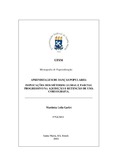| dc.contributor.advisor | Corazza, Sara Teresinha | |
| dc.creator | Garlet, Martinha Leila | |
| dc.date.accessioned | 2016-07-18T13:42:45Z | |
| dc.date.available | 2016-07-18T13:42:45Z | |
| dc.date.issued | 2004-05-06 | |
| dc.date.submitted | 2004 | |
| dc.identifier.uri | http://repositorio.ufsm.br/handle/1/1906 | |
| dc.description | Monografia (especialização) - Universidade Federal de Santa Maria, Centro de Educação Física e Desporto, Curso de Especialização em Pesquisa e Ensino em Ciência do Movimento Humano, RS, 2004. | por |
| dc.description.abstract | The dance is a motor ability that, now, it is present in a lot of
schools being part of the contents and assuming an educational function.
However, frequently, the teachers are insecure as for the method that
should use so that the apprentice could be benefit in the learning and in
the retention of movements of a dance choreography. The present study
had as the objective to verify which of the methods, Global or Partial
Progressive, is more effective on acquiring and retaining popular
dancing movements. A sample of 24 children between 10 and 11 years
old, participated in this survey, all of them enrolled in Elementary Public
School Profª Cândida Zasso. Two groups were formed with 12 children
in each. Group 1 worked with the global method and the second with the
partial progressive. There were 8 practical sessions for both groups with
an interval of 48 hours from one session to the other. At the end of the 8th
session there was an acquisition test to verify how much the student had
learnt throughout the learning process. After a 48 hours interval, without
any practice, It was applied another test to verify how much the student
had retained in a long-term memory. The data were analyzed through the
test “t” of student in order to verify the existence of differences between
groups. It was found p = - 0,576 in the acquisition test while p = - 0,463
in the retaining test. According to these results it was noticed that there is
no meaningful statistical difference between the methods in the learning
process of a popular dance choreography. | eng |
| dc.language | por | por |
| dc.publisher | Universidade Federal de Santa Maria | por |
| dc.rights | Acesso Aberto | por |
| dc.subject | Educação física | por |
| dc.subject | Dança popular | por |
| dc.subject | Dança | por |
| dc.subject | Coreografia | por |
| dc.subject | Aprendizagem | por |
| dc.title | Aprendizagem de danças populares: implicações dos métodos global e parcial progressivo na aquisição e retenção de uma coreografia | por |
| dc.title.alternative | The learning of a popular dance: implications of global and partial progressive methods in the acquisition and retention of choreography | eng |
| dc.type | Trabalho de Conclusão de Curso de Especialização | por |
| dc.degree.local | Santa Maria, RS, Brasil. | por |
| dc.degree.specialization | Pesquisa e Ensino em Ciência do Movimento Humano | por |
| dc.description.resumo | Atualmente a habilidade motora dança está presente nas Escolas, fazendo
parte dos conteúdos e assumindo uma função educativa. Porém muitas vezes o
professor fica inseguro quanto ao método que deve utilizar, para que o aprendiz, seja
beneficiado tanto na aprendizagem, como na retenção de movimentos de uma
coreografia de dança. O presente estudo teve como objetivo, verificar qual dos
métodos global ou parcial progressivo é mais eficiente na aquisição e retenção de
movimentos de uma dança popular. Participaram deste estudo uma amostra de 24
crianças, com idade entre 10 e 11 anos, todas matriculadas na Escola Municipal de
Ensino Fundamental Profª Cândida Zasso, Formou-se dois grupos com 12 crianças
em cada um, sendo que o grupo 01 trabalhou com o método global e o grupo 02
trabalhou com o método parcial progressivo. Foram realizadas 08 sessões práticas de
treinamento para ambos os grupos com o intervalo de 48 horas de uma sessão para
outra. Ao final da oitava sessão foi realizado o teste de aquisição que serviu de base
para verificar o quanto o indivíduo aprendeu durante o processo de aprendizagem.
Após um intervalo de 48 horas sem realização de nenhuma prática foi aplicados o
teste de retenção com o objetivo de verificar o quanto o indivíduo reteram
informações na memória de longo prazo. Os dados foram analisados através da
aplicação do teste “t” de student, a fim de verificar a existência de diferenças entre os
grupos, sendo encontrado no teste de aquisição o valor de p= -0,576 e no teste de
retenção p= -0,463. Percebe-se com estes resultados que não houve diferença
estatisticamente significativa de um método sobre o outro no desempenho da
coreografia de uma dança popular. | por |
| dc.publisher.unidade | Centro de Educação Física e Desportos | por |


